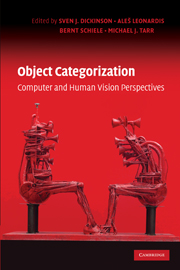Book contents
- Frontmatter
- Contents
- Preface
- Contributors
- 1 The Evolution of Object Categorization and the Challenge of Image Abstraction
- 2 A Strategy for Understanding How the Brain Accomplishes Object Recognition
- 3 Visual Recognition Circa 2008
- 4 On What It Means to See, and WhatWe Can Do About It
- 5 Generic Object Recognition by Inference of 3-D Volumetric Parts
- 6 What Has fMRI Taught Us About Object Recognition?
- 7 Object Recognition Through Reasoning About Functionality: A Survey of Related Work
- 8 The Interface Theory of Perception: Natural Selection Drives True Perception to Swift Extinction
- 9 Words and Pictures: Categories, Modifiers, Depiction, and Iconography
- 10 Structural Representation of Object Shape in the Brain
- 11 Learning Hierarchical Compositional Representations of Object Structure
- 12 Object Categorization in Man, Monkey, and Machine: Some Answers and Some Open Questions
- 13 Learning Compositional Models for Object Categories from Small Sample Sets
- 14 The Neurophysiology and Computational Mechanisms of Object Representation
- 15 From Classification to Full Object Interpretation
- 16 Visual Object Discovery
- 17 Towards Integration of Different Paradigms in Modeling, Representation, and Learning of Visual Categories
- 18 Acquisition and Disruption of Category Specificity in the Ventral Visual Stream: The Case of Late Developing and Vulnerable Face-Related Cortex
- 19 Using Simple Features and Relations
- 20 The Proactive Brain: Using Memory-Based Predictions in Visual Recognition
- 21 Spatial Pyramid Matching
- 22 Visual Learning for Optimal Decisions in the Human Brain
- 23 Shapes and Shock Graphs: From Segmented Shapes to Shapes Embedded in Images
- 24 Neural Encoding of Scene Statistics for Surface and Object Inference
- 25 Medial Models for Vision
- 26 Multimodal Categorization
- 27 Comparing 2-D Images of 3-D Objects
- Index
- Plate section
13 - Learning Compositional Models for Object Categories from Small Sample Sets
Published online by Cambridge University Press: 20 May 2010
- Frontmatter
- Contents
- Preface
- Contributors
- 1 The Evolution of Object Categorization and the Challenge of Image Abstraction
- 2 A Strategy for Understanding How the Brain Accomplishes Object Recognition
- 3 Visual Recognition Circa 2008
- 4 On What It Means to See, and WhatWe Can Do About It
- 5 Generic Object Recognition by Inference of 3-D Volumetric Parts
- 6 What Has fMRI Taught Us About Object Recognition?
- 7 Object Recognition Through Reasoning About Functionality: A Survey of Related Work
- 8 The Interface Theory of Perception: Natural Selection Drives True Perception to Swift Extinction
- 9 Words and Pictures: Categories, Modifiers, Depiction, and Iconography
- 10 Structural Representation of Object Shape in the Brain
- 11 Learning Hierarchical Compositional Representations of Object Structure
- 12 Object Categorization in Man, Monkey, and Machine: Some Answers and Some Open Questions
- 13 Learning Compositional Models for Object Categories from Small Sample Sets
- 14 The Neurophysiology and Computational Mechanisms of Object Representation
- 15 From Classification to Full Object Interpretation
- 16 Visual Object Discovery
- 17 Towards Integration of Different Paradigms in Modeling, Representation, and Learning of Visual Categories
- 18 Acquisition and Disruption of Category Specificity in the Ventral Visual Stream: The Case of Late Developing and Vulnerable Face-Related Cortex
- 19 Using Simple Features and Relations
- 20 The Proactive Brain: Using Memory-Based Predictions in Visual Recognition
- 21 Spatial Pyramid Matching
- 22 Visual Learning for Optimal Decisions in the Human Brain
- 23 Shapes and Shock Graphs: From Segmented Shapes to Shapes Embedded in Images
- 24 Neural Encoding of Scene Statistics for Surface and Object Inference
- 25 Medial Models for Vision
- 26 Multimodal Categorization
- 27 Comparing 2-D Images of 3-D Objects
- Index
- Plate section
Summary
Introduction
Modeling object categories is a challenging task owing to the many structural variations between instances of the same category. There have been many nonhierarchical approaches to modeling object categories, all with limited levels of success. Appearance-based models, which represent objects primarily by their photometric properties, such as global PGA, KPCA, fragments, SIFTs, and patches (Lowe 2004; Nayar et al. 1996; Ullman et al. 2001; Weber et al. 2000), tend to disregard geometric information about the position of important keypoints within an object. Thus, they are not well-suited for recognition in scenarios where pose, occlusion, or part reconfiguration are factors. Structure-based models, which include information about relative or absolute positions of features, such as the constellation model and pictorial structures (Felzenszwalb and Huttenlocher 2005; Fischler and Elschlager 1973;Weber et al. 2000), are more powerful than appearance-based approaches as they can model relationships between groups of parts and thus improve recognition accuracy, but are rarely hierarchical and, as such, cannot account for radical transformations of the part positions.
Very recently there has been a resurgence in modeling object categories using grammars (Jin and Geman 2006; Todorovic and Ahuja 2006; Zhu and Mumford 2006). Work by Fu (Fu 1981; You and Fu 1980) and Ohta (1985) in the 1970s and 1980s, and later by Dickinson and Siddiqi (Dickinson et al. 1992; Keselman and Dickinson 2001; Siddiqi et al. 199?) introduced these grammars to account for structural variance. Han and Zhu (2005) and Chen et al. (2006) used attributed graph grammars to describe rectilinear scenes and model clothes, but these models were hardcoded for one category of images.
- Type
- Chapter
- Information
- Object CategorizationComputer and Human Vision Perspectives, pp. 241 - 256Publisher: Cambridge University PressPrint publication year: 2009
- 5
- Cited by

